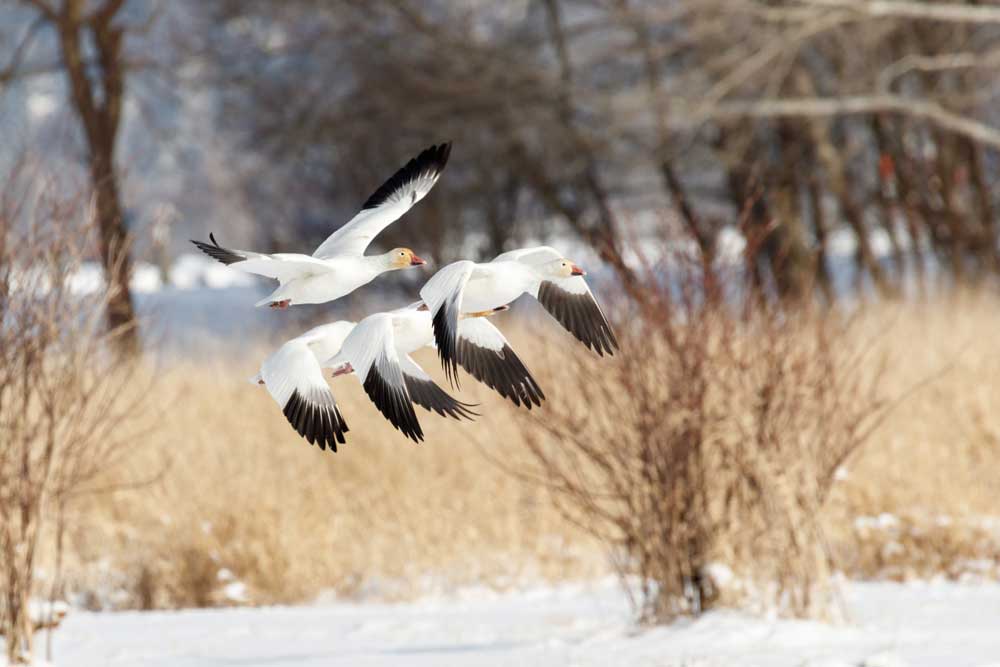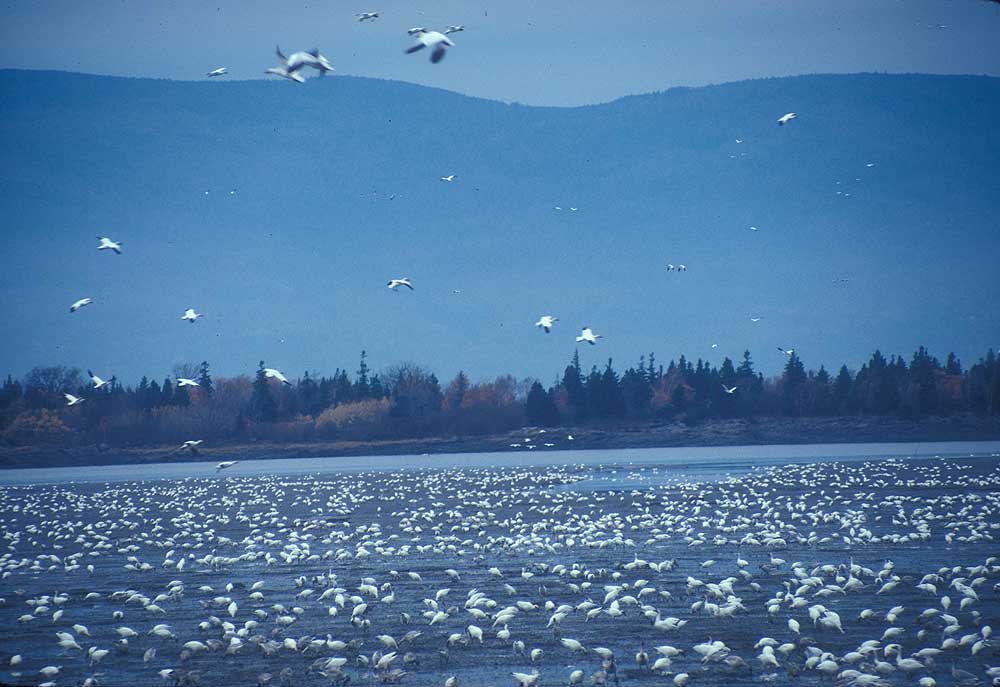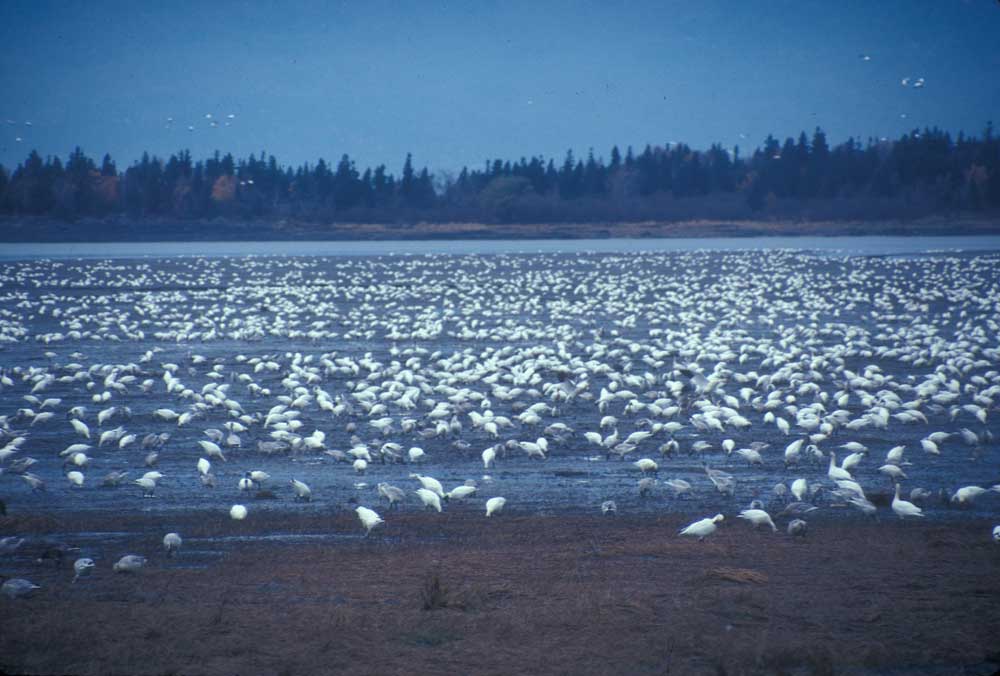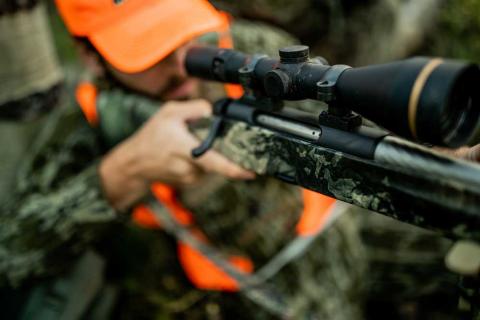Bob Humphrey
Light geese, snows, a blizzard on wings; once considered three separate species, lesser and greater snow geese and blue geese are now all now considered the same species: Snow Goose (Anser caerulescens). Populations and races are differentiated by size and breeding range. They do occasionally interbreed with the similar, but smaller Ross’s goose (Chen rossii), which is still considered a separate species.
Description

Adult lesser snow geese have two color phases. The plumage of white phase geese is all white, except for black wing tips. Dark or blue phase geese have mostly white head and neck, grayish-brown back and varying amounts of white on the underparts. Heads of both are sometimes stained rusty brown from minerals in the soil where they feed. Both phases have pink legs and feet and pinkish bills with a dark grinning patch. Immature white phase birds are white with a pale gray back and neck. Blue phase immature birds are brownish gray. Both have dark legs. Greater snow geese are slightly larger and do not have a blue phase.
Lesser
- Average length: Male: 29", Female 28"
- Average weight: Male 6.1 lbs., Female 5.5 lbs.
Greater
- Average length: M 31", F 30"
- Average weight: M 7.4 lbs., F 6.1 lbs.
Breeding Range and Distribution
According to the U.S. Fish and Wildlife Service, there are three populations of lesser snow geese based on their breeding ranges.
The Mid-continent population (MCP) nests from Banks Island in the western Arctic to Baffin Island in the eastern Arctic, and winters in the Central and Mississippi Flyways.
The Western Arctic population (WAP) nests on Banks Island, with smaller colonies in coastal areas of the Northwest Territories, and along the Alaskan Arctic Coastal Plain and winters in central and southern California, the western Central Flyway, and the northern highlands of Mexico.
As their name implies, the Wrangel Island population (WAP) nests on Wrangel Island, Russia, and winters in the Skagit-Fraser River Deltas in British Columbia and Washington and in northern and central California.

Greater snow geese nest on Bylot, Axel Heiberg, Ellesmere, and Baffin Islands, and in Greenland, and winter along the Atlantic coast from New Jersey to North Carolina. Their primary spring staging area is near the St. Lawrence Valley in Quebec.
Lessers nest on low, grassy tundra plains, and broad, shallow rivers near the coast, and on islands within shallow inland lakes. They nest in colonies and lay an average of 4-5 eggs. Greaters nest in colonies on well-drained westward slopes or vegetated hilltops, and lay an average of four eggs.
Migrating and Wintering
Lesser snow geese migrate down the Pacific and Mississippi Flyways. Historic winter range is the Central Valley of California and the Gulf Coast of Texas, Louisiana, and Mexico, where they feed on emergent vegetation in the brackish and salt marshes. That range has expanded recently to interior agricultural lands in Arkansas, Mississippi, Louisiana and Texas.
Greater snow geese migrate primarily down a narrow corridor of the Atlantic Flyway and winter on the mid-Atlantic coast from New Jersey to North Carolina.
Conservation and Hunting

By the late 90s, lesser snow geese had become victims of their own success. The Mid-continent population was estimated at around 8 million birds, and would more than double over the next decade. Those numbers resulted in coastal marsh habitat in critical staging areas to be seriously degraded and in some cases destroyed. In an effort to protect remaining habitat, waterfowl managers enacted the Light Goose Conservation Order, liberalizing bag limits and regulations and expanding season lengths. With seasons of over 100 days, 20-bird daily bag limits, un-plugged shotguns and electronic calls, the harvest doubled, but failed to keep pace with population growth. Similar efforts directed toward the greater snow goose population have been more successful, but early spring conservation seasons remain for both races.
Snow goose hunting is a serious undertaking. Unlike Canadas, which can be lured in with a couple dozen decoys, snow spreads require hundreds. Snows typically travel in larger flocks and adults are super wary. Spreads often include full bodies, shells, socks, silhouettes and even kites.
The sound of an approaching flock can be deafening and when they set their wings and commit, you’re overwhelmed with a storm of giant snowflakes. Guns go off and mayhem ensues as you quickly re-load, and hunter and dog frantically focus on single targets. Things have barely settled down when the next flock comes and the scene is repeated again and again.




























